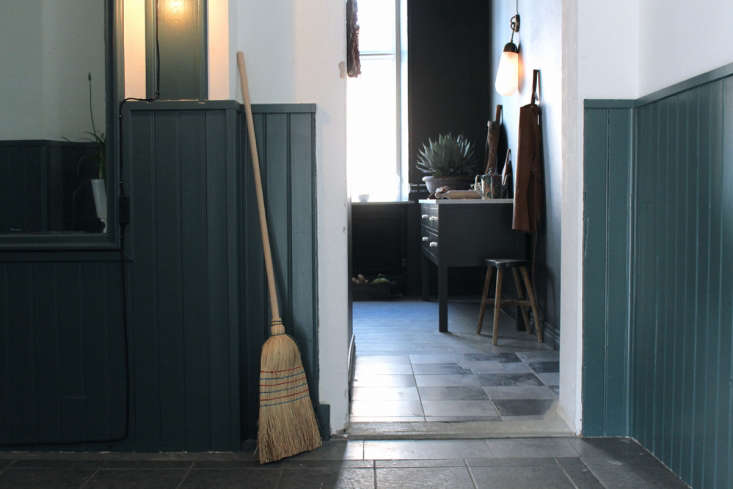Lately we’ve been doing a deep dive into the wonderful world of moldings. Who knew how much there is to know about trim—and how useful it can be, from concealing slightly uneven flooring to hiding the outlets? In today’s installment we’re tackling chair rails, picture rails, and wainscoting. Here’s what you need to know, with help from architect James Dixon, a member of the Remodelista Architect & Designer Directory.
What are chair rails?

Today’s chair rails are purely decorative, but that’s not how they started out. “In the old days, people used to push their furniture up against the walls, and the chair rail kept the tops of the chairs from digging up the plaster,” Dixon says. These days, chair rails are still being installed in new houses as a way to establish the proportions of a room by creating a separate zone.
Where should a chair rail be positioned on a wall?
“The chair rail was originally placed at around a third the height of the wall, which put it at the height of your average chair back,” says Dixon. Now it depends more on the height of the room. “If the ceiling is really high, instead of using the one-third rule you might want to move the chair rail down a bit so it won’t look odd.”

What color should a chair rail be?
“Some people paint the chair rail and the wall below it one color, and then treat the wall above in a different color,” says Dixon. “A chair rail can also be stained a dark color rather than painted; you see that a lot in Arts & Crafts–style houses.”
But what Dixon prefers is to paint everything from floor to ceiling the same color. “Then the chair rail just creates a subtle line, giving you some shadows around the space.”
What about the material and design for chair rails?
Chair rail molding is typically made of wood, but it can be a composite material. “There’s endless variety out there, and your choice depends on the style of your room,” says Dixon.
As for the design, Dixon feels that all the trim in a room should be part of the same family, with similar detail and proportions. Chair rail does tend to be simpler than other moldings, though you can get fancy carved shapes. And it’s usually fairly flat—“You don’t want it to project too far out from the wall, or people will bump up against it.”
What is wainscoting?

Sometimes more molding is installed below a chair rail to create a wainscot (also called wainscoting), or at least the illusion of one. While a traditional wainscot is made of framed wooden panels, molding can re-create the look without the panels themselves. The molding will add character to the room and help protect the walls from scuffs and dents.
What are picture rails?

Like chair rails, these were once installed for functional purposes. “There was a time when people were constantly changing the pictures on their walls,” says Dixon. “Instead of pounding in a nail to hang great-grandmother’s portrait, you could hang it on a wire or cord attached to the picture rail, and swap it out later without leaving any holes in the plaster.” Picture rails are still seen, but less often than before. They may not be used for hanging pictures; they’re more to delineate a space.
Where do you install a picture rail?
Typically, about nine inches below the ceiling. If you are using it to hang pictures, it should be high enough that you can adjust the height of the pictures. And if you have a fancy cornice, you want it low enough that you don’t damage the cornice.

What color should a picture rail be?
It depends on the style of the room and the decorative elements. A wooden picture rail can be stained, and, as with chair rails, “some people paint the walls up to and including the picture rail one color, and make everything above that a different color,” says Dixon. “I find that makes the ceiling look lower. I prefer to take the same wall color all the way up the wall to the cornice.”
What are plate rails?

Plate rails for displaying ceramics and such are another way to use molding on a wall. They might be installed lower than a picture rail to show off your belongings to better advantage. A ridge on the outside of the rail keeps pieces safely in place.
Where can I find more information about moldings?
Dixon refers you to what he calls the “bible,” C. Howard Walker’s Theory of Mouldings. Though it was first published in 1926, it’s surprisingly still in print.
He also suggests checking out the catalog of Dykes Lumber Co., founded in Manhattan in 1909. “The Dykes catalog has every kind of molding in every category,” he says. “It’s a great resource for people in the industry who live and breathe this subject.”
Plus, see our other posts on the subject:
- Remodeling 101: What Is Crown Molding? Plus, What You Need to Know
- Remodeling 101: Everything You Need to Know About Door and Window Trim
- Remodeling 101: Consider the Baseboard (and, What You Need to Know)




Have a Question or Comment About This Post?
Join the conversation (0)